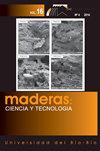比较了紫曲霉和红球霉生物降解云杉木材的结构及其进一步利用
IF 1.5
4区 农林科学
Q3 MATERIALS SCIENCE, PAPER & WOOD
引用次数: 0
摘要
新材料的开发非常重视节约生产成本、能源、减少生产过程中使用的化学品的数量和数量。生物基材料可以生态生产,使用寿命结束后可以循环利用,节约了环境。最近对生物基材料的兴趣导致了这项工作的目标。以云杉为研究对象,研究了白腐菌和褐腐菌对云杉木材的降解作用。对木材的结构进行了宏观和微观观察。在这项工作中使用了经典和不寻常的染色组合。在制作永久坐骑的过程中故意省略了乙醇。这样做是为了保持衰变显微切片的一致性,并防止小碎片被冲洗掉。观察结果表明,被这些真菌腐烂的云杉木材可以用作隔热材料。木材腐烂真菌降低木材的密度,增加木材的孔隙率。低密度和高孔隙率是绝缘材料的重要性能。结果表明,经紫曲霉腐烂的云杉木材更适合作为绝缘材料。本文章由计算机程序翻译,如有差异,请以英文原文为准。
Comparing the structure of spruce wood biodegraded by Trametes versicolor and Gloeophyllum trabeum and further utilization of this material
Development of new materials puts a great emphasis on saving production costs, energy, decreasing the amount and number of chemicals used during the manufacturing process. Bio-based materials can be ecologically produced and recycled after their lifespan, which saves the environment. The recent interest in bio-based materials led to the objective of this work. In this article, the structure of spruce wood ( Picea abies ) biodegraded by the white-rot fungus Trametes versicolor and brown-rot fungus Gloeophyllum trabeum was studied. Structure of the wood was observed macroscopically and microscopically. Classic and unusual stain combinations were used in this work. Ethanol was intentionally omitted in the process of making permanent mounts. It was done to preserve the coherence of the decayed microsections and to keep small fragments from being rinsed away. Results of the observations suggest that spruce wood decayed by these fungi could be used as an insulation material. Wood decaying fungi decrease the density of wood and increase its porosity. A low density and high porosity are important properties for insulation materials. According to the results, spruce wood decayed by Trametes versicolor would be more suitable to be used as an insulating material.
求助全文
通过发布文献求助,成功后即可免费获取论文全文。
去求助
来源期刊

Maderas-ciencia Y Tecnologia
工程技术-材料科学:纸与木材
CiteScore
2.60
自引率
13.30%
发文量
33
审稿时长
>12 weeks
期刊介绍:
Maderas-Cienc Tecnol publishes inedits and original research articles in Spanish and English. The contributions for their publication should be unpublished and the journal is reserved all the rights of reproduction of the content of the same ones. All the articles are subjected to evaluation to the Publishing Committee or external consultants. At least two reviewers under double blind system. Previous acceptance of the Publishing Committee, summaries of thesis of Magíster and Doctorate are also published, technical opinions, revision of books and reports of congresses, related with the Science and the Technology of the Wood. The journal have not articles processing and submission charges.
 求助内容:
求助内容: 应助结果提醒方式:
应助结果提醒方式:


